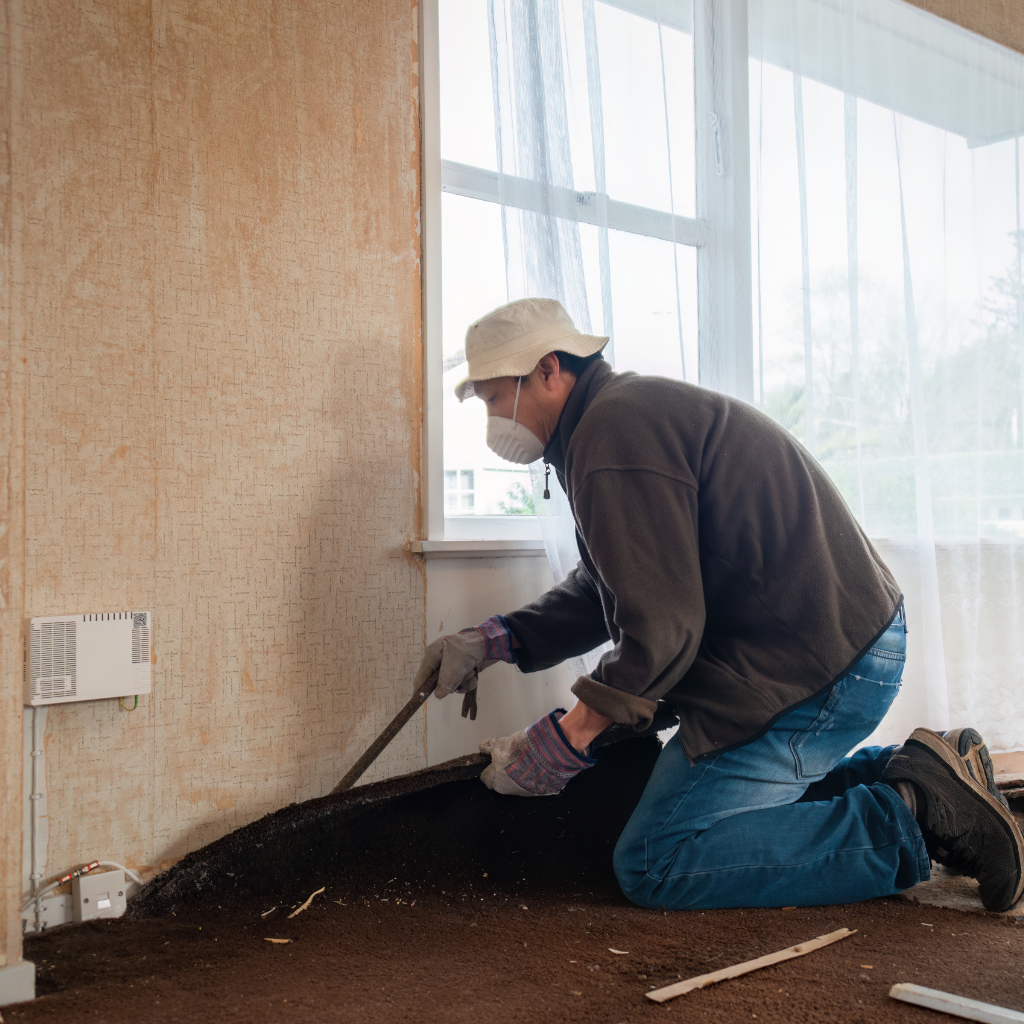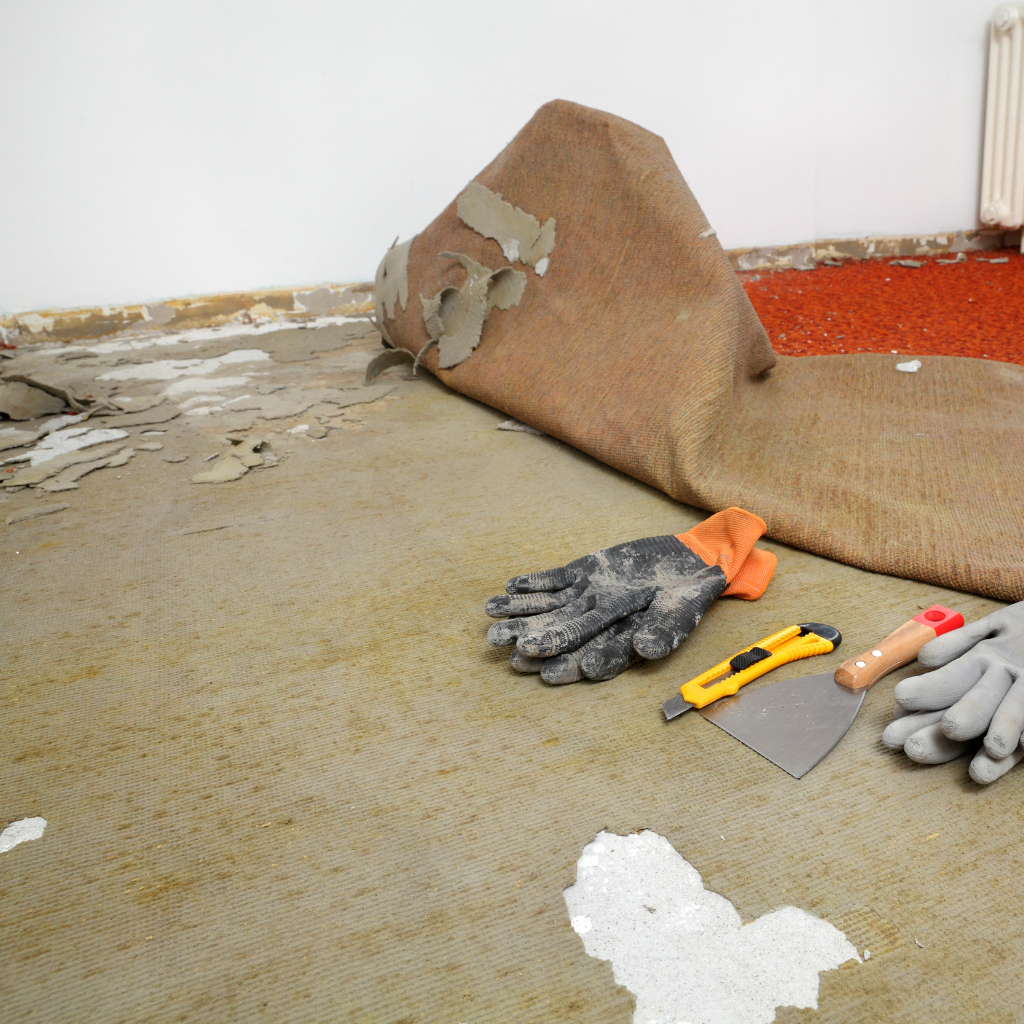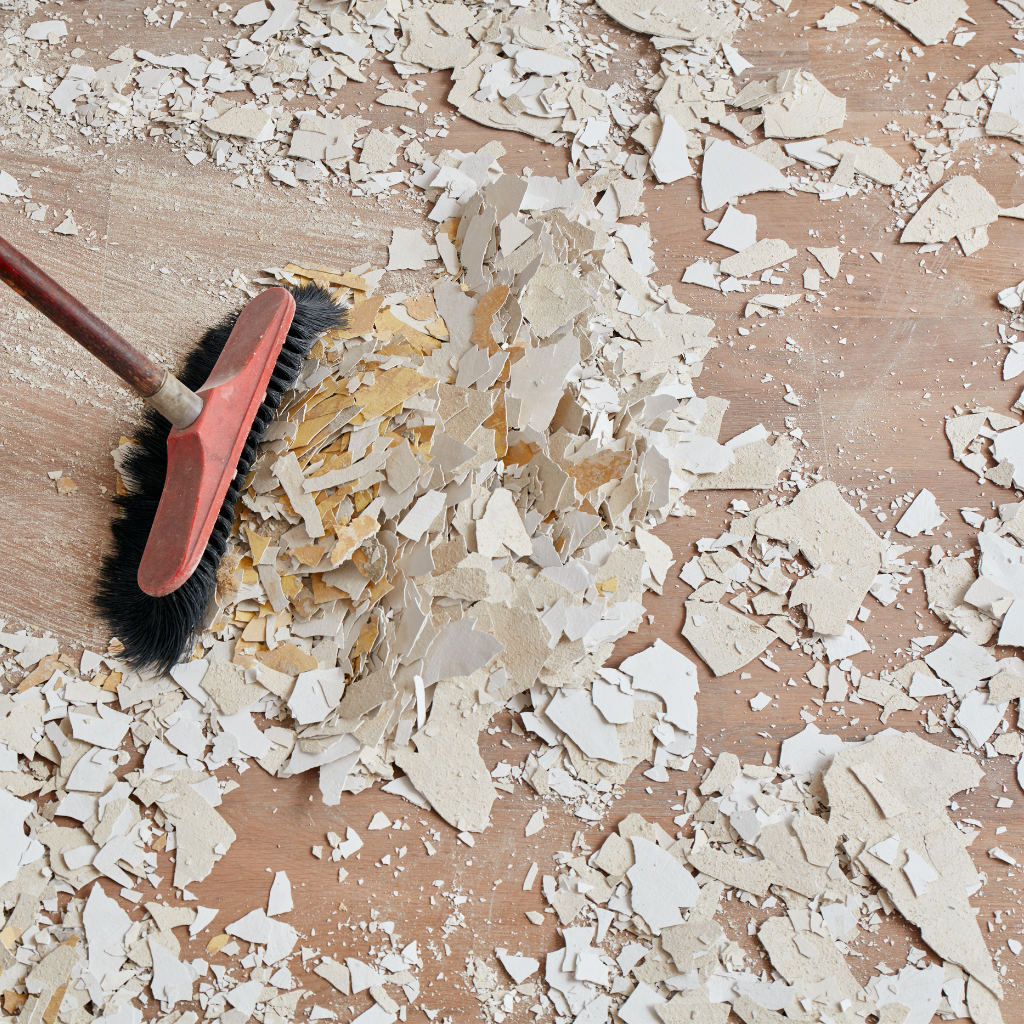To remove carpet from concrete without causing damage, start by cutting the carpet into strips using a utility knife and rolling them up as you go. Then, cautiously pry up tack strips and scrape away adhesive with a floor scraper. Utilise glue remover for any stubborn residue, and guarantee the area is thoroughly cleaned afterwards. This methodical approach preserves the concrete while preparing it for new flooring. Discover further details about handling different situations below.
Key Takeaways
To begin the carpet removal process, first cut the carpet into manageable sections using a sharp utility knife, ensuring each piece is small enough to handle comfortably.
Next, remove the carpet tack strips and any underlay underneath, taking care not to damage the concrete surface.
Finally, prepare the concrete floor for cleaning by sweeping away all debris and detaching any remaining adhesive or underlay remnants.

Starting the carpet removal process involves cutting the carpet into manageable sections, which simplifies the task of peeling it off the concrete.
To effectively remove carpet from a concrete floor, one should use a sharp utility knife to cut the carpet into manageable strips, approximately 3 to 4 feet wide. This size allows for easier handling and disposal.
Begin by making an incision at one corner of the room and carefully extend the cut across the width of the carpet. Ascertain that the blade is sharp enough to slice through both the carpet and any underlying carpet underlay, reducing resistance and preventing tearing.
As the sections of carpet are cut, roll them up for efficient removal, keeping the work area clear and manageable.
Once the carpet is cut and rolled away, the focus shifts to removing the tack strips and underlay adhered to the concrete.
To remove the tack strip, slide a pry bar under the tack, gently prying it up to avoid damaging the concrete beneath. It's essential to work slowly and methodically to detach the carpet tack strips securely fixed along the perimeter.
Next, tackle the underlay; if it's glued down, use a floor scraper to lift and peel away the material. This step is crucial when replacing old flooring with more durable options like Commercial Carpet Tiles, which require a clean and even concrete surface for proper installation.
To remove carpet glue residues, apply an adhesive remover designed for concrete surfaces. This helps in softening the carpet adhesive, making it easier to scrape off without leaving harmful remnants on the concrete surface.
After removing the carpet tack strips and underlay, the next step involves thoroughly cleaning the concrete floor to guarantee a smooth and clean surface. Often, removing carpet adhesive from the surface is challenging, especially when dealing with old carpet glue. A practical approach includes scraping off as much adhesive residue as possible using a sturdy scraper. To effectively remove carpet glue from concrete, it's crucial to soften the remaining carpet glue first, which can be done using a commercial adhesive remover.
| Step | Tool/Chemical | Purpose |
|---|---|---|
| Scrape | Heavy-duty scraper | Remove loose glue residue |
| Apply | Adhesive remover | Soften old carpet glue |
| Scrub | Stiff brush | Agitate softened glue |
| Wipe | Clean cloth | Remove remaining residue |
| Rinse | Water | Clean the concrete surface |
This method guarantees the concrete is free of carpet glue from concrete floors and ready for further treatment or flooring installation.
To effectively remove carpet from concrete, one needs a specific set of tools, including a utility knife, pry bar and hammer.
Additionally, materials such as adhesive removers and concrete cleaners are vital for preparing the underlying surface post-removal.
It is also essential to equip oneself with protective gear, such as gloves, goggles, and knee pads, to guarantee safety throughout the process.
Several essential tools and materials are required to remove carpets from concrete floors efficiently. Initially, a utility knife is indispensable for cutting the carpet into strips, making it easier to handle. Pliers and a hand scraper aid in the removal of tack strips and residual adhesives. A floor scraper is further necessary for tackling larger areas of glue and underlay.
For safety, it is vital to wear gloves, knee pads, eye protection, and a respirator to guard against dust and sharp objects. An angle grinder may be needed for particularly stubborn adhesive patches. Here's a concise table of tools for carpet removal:
| Tool | Use | Safety Gear Required |
|---|---|---|
| Utility Knife | Cutting the carpet | Gloves, Eye Protection |
| Plier | Removing nails and tack strips | Gloves |
| Hand Scraper | Scraping off residues | Gloves, Respirator |
| Floor Scraper | Cleaning larger surface areas | Gloves, Knee Pads |
| Angle Grinder | Removing tough adhesives | Eye Protection, Respirator |
Once the carpet has been removed, attention must shift towards thoroughly cleaning the now-exposed concrete floor.
To effectively clean the surface, start by using a floor scraper to remove any old adhesive or remnants of carpet glue. This will help clear the significant debris and prepare the concrete for finer cleaning.
Next, a specialised glue remover will be applied to tackle any persisting glue residues without damaging the concrete. It's essential to choose a product that is effective yet devoid of harsh chemicals that could erode the concrete surface.
After applying the glue remover, use a stiff brush to scrub the area, ensuring all residues are dislodged.
Finally, sweep up any remaining dust and debris to leave the concrete clean and smooth.
Before initiating the process of removing carpet from concrete, it is essential to equip oneself with the appropriate safety gear to prevent injuries and guarantee a smooth operation.
Safety goggles and a respirator mask are vital to shield against dangerous fumes and airborne particles. Durable gloves are necessary to protect your hands while handling sharp tools like utility knives, which are used to cut and secure the carpet edges.
Employ a scraper with a sharp blade to scrape off residual glue, requiring significant elbow grease, effectively. A scraper's flat end proves instrumental in lifting the carpet without damaging the concrete underneath.
Additionally, knee pads are recommended for comfort during prolonged periods of kneeling and scraping.
Once the carpet is removed, residual glue on concrete floors can be tackled initially with a floor scraper to remove as much adhesive as possible.
For more stubborn glue deposits, applying a commercial glue remover according to the manufacturer's instructions will help soften and lift the adhesive.
If remnants persist, utilising a putty knife combined with manual effort can effectively clear the surface.
Removing carpet glue from concrete floors effectively requires the use of a floor scraper, a tool designed for this purpose.
To tackle stubborn carpet glue, first, soften the glue by applying heat or a suitable solvent. Once the adhesive is softened, use the floor scraper to remove the residue methodically.
Start by positioning the scraper at an angle to the concrete surface, applying steady pressure as you push forward. For tough spots, employ a utility knife to cut through the thickest layers of glue, making it easier for the floor scraper to get underneath and lift the adhesive.
Guarantee each section is thoroughly scraped to prepare the concrete for any new flooring installation. Repeat until all adhesive is removed.
For those persistent patches of carpet glue that resist scraping, applying a commercial glue remover can be an effective solution.
When tackling the task of removing carpet glue from paint or concrete, first verify that the area is well-ventilated. Apply the glue remover directly to the stubborn spots, following the manufacturer's instructions for the amount and application method.
Allow the remover sufficient time to soften the dry glue. This process breaks down the adhesive properties, making it easier to scrape away the remaining glue from the concrete.
After the recommended waiting time, use a floor scraper to remove the softened adhesive gently.
Thoroughly clean the surface afterwards to verify all traces of glue and remover are eliminated, leaving the concrete clean and undamaged.
When tackling particularly tenacious carpet glue on concrete floors, a putty knife can prove invaluable.
Once the carpet is removed, residual glue on the floor often remains, complicating the removal process. Here are four methodical steps to effectively use this tool:

After removing the carpet from the concrete, it is crucial to address any remaining adhesive residue to guarantee a clean surface.
Best practices include using specific solvents or mechanical methods tailored to the type of glue used, which helps prevent damage to the concrete.
Additionally, avoiding common mistakes such as overly aggressive scraping or using inappropriate chemicals can safeguard the integrity of the concrete during cleaning.
Removing carpet adhesive residue from concrete surfaces requires careful attention to detail to guarantee a clean and smooth finish.
After removing the old carpet from the concrete, the remaining carpet adhesive residue can be stubborn. Here are the recommended tools and methods for effectively cleaning the concrete:
Guaranteeing a clean concrete surface following carpet removal involves a series of meticulous steps to avoid damage and prepare for new flooring installation.
After you have successfully pulled the carpet and peeled away any layer of carpet stuck to the concrete, focus on the subfloor.
Begin by meticulously scraping edges and areas where the adhesive has hardened. For residues that are difficult to remove, consider using a specialised solvent that does not damage the concrete.
Sweep the entire area to collect loose debris and dust. Finally, wash the concrete with a pH-neutral cleaner to confirm no harmful residues remain. This thorough cleaning is essential for those needing to remove carpet to prepare for tile or other flooring types.
While the previous discussion outlined the steps necessary for a clean concrete surface after removing the carpet, it's equally important to avoid specific errors during the cleaning process.
The following list highlights key mistakes to avoid:
In considering professional carpet removal from concrete, it is vital to recognise the signs that indicate the need for expert intervention.
These signs might include the presence of extensive adhesive, subfloor damage, or hazardous materials like asbestos.
Additionally, understanding the associated costs, which can vary based on the project's complexity and the professional's experience, is essential for budget planning.

If carpet removal from concrete surfaces appears complex or the how to remove carpet from concrete that is adhered to too firmly, it might be prudent to seek professional assistance.
Here are signs indicating when professional help is necessary:
Deciding to hire a professional for carpet removal from concrete involves understanding the associated costs.
These expenses can vary based on the room size, flooring type beneath, and the condition of the underlying concrete.
Professionals use the right tools and follow a step-by-step guide to guarantee the surface is ready for new flooring installation, whether it's vinyl flooring, laminate flooring, or hardwood floors.
They manage the project by dividing the space into manageable sections to cover efficiently. If you're considering new flooring types, factor in these costs to avoid surprises.
Ultimately, evaluating whether the job or project is within your skill set or requires professional intervention is critical in managing your budget effectively.
To summarise, removing carpet from concrete requires careful planning and execution to avoid damage. Start by gathering the necessary tools and materials, then methodically detach and dispose of the carpet. Remove residual glue with appropriate solvents or techniques and thoroughly clean the concrete surface. Once the concrete is adequately cleaned and prepped, it's ready if you plan to lay kitchen carpet tiles or install another type of flooring. If the project proves too challenging or if the concrete is at risk of damage, consider enlisting a professional. This approach guarantees a clean and prepared surface for your next flooring installation.